Customer Satisfaction, Patient Engagement and OOP in US Healthcare
VerifiedAdded on 2022/08/15
|12
|4535
|16
Essay
AI Summary
This essay delves into the challenges of the Out-of-Pocket (OOP) model within the US healthcare system, focusing on its impact on customer satisfaction and patient engagement. The paper highlights the complexities of the US healthcare landscape, contrasting different insurance models and emphasizing the hybrid nature of the system. The discussion addresses the issues of low patient engagement, often resulting from the complexity of the healthcare setting and the attitudes of patients and providers, and the financial burdens placed on individuals by the OOP model. The essay then proposes solutions, including patient education, improved collection practices, and effective communication strategies, to mitigate these challenges and enhance the overall healthcare experience. The paper underscores the importance of understanding the link between patient engagement, satisfaction, and financial transactions for improved healthcare outcomes. Finally, the essay presents the implementation of the proposed solutions in the healthcare system.
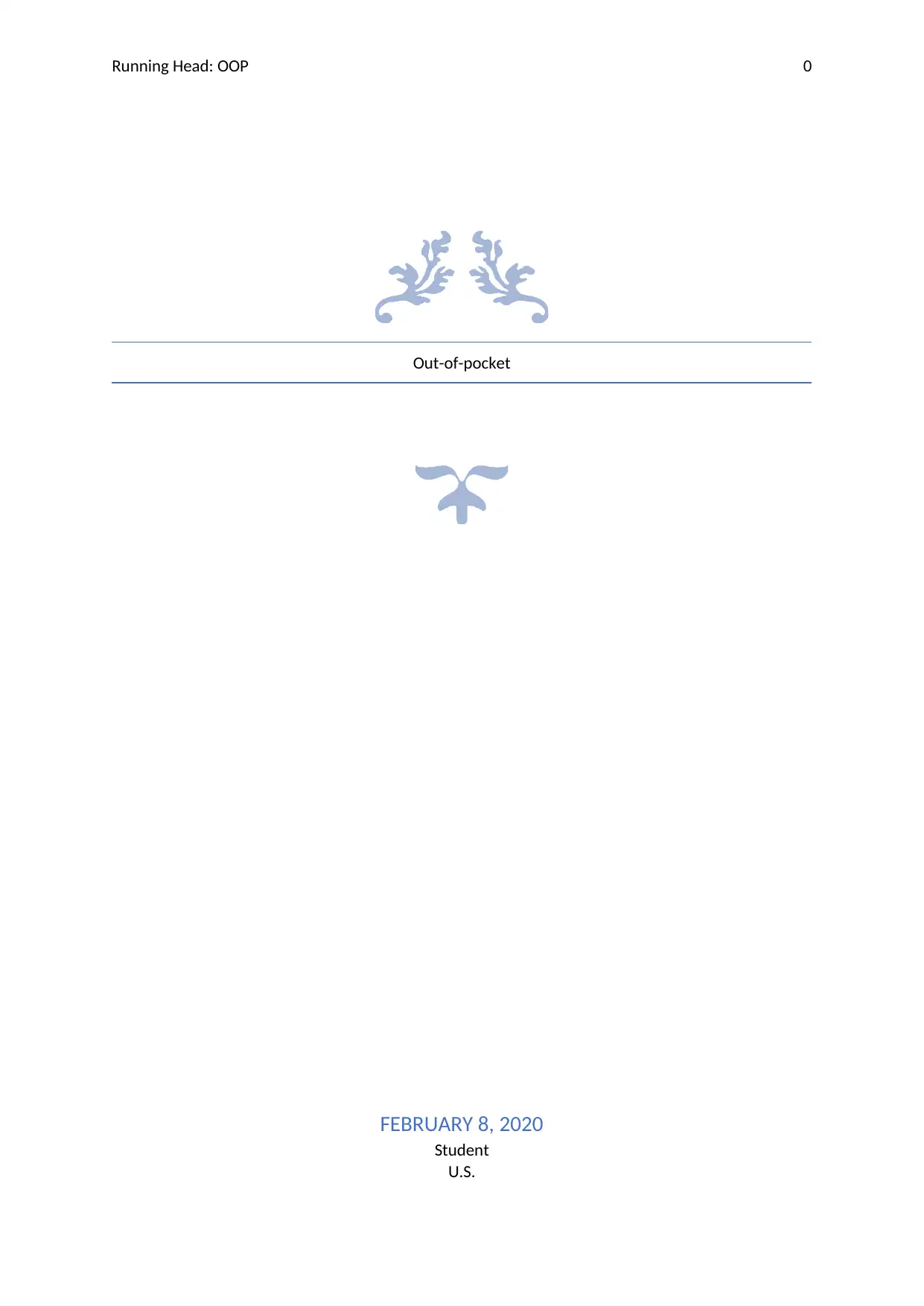
Running Head: OOP 0
Out-of-pocket
FEBRUARY 8, 2020
Student
U.S.
Out-of-pocket
FEBRUARY 8, 2020
Student
U.S.
Paraphrase This Document
Need a fresh take? Get an instant paraphrase of this document with our AI Paraphraser
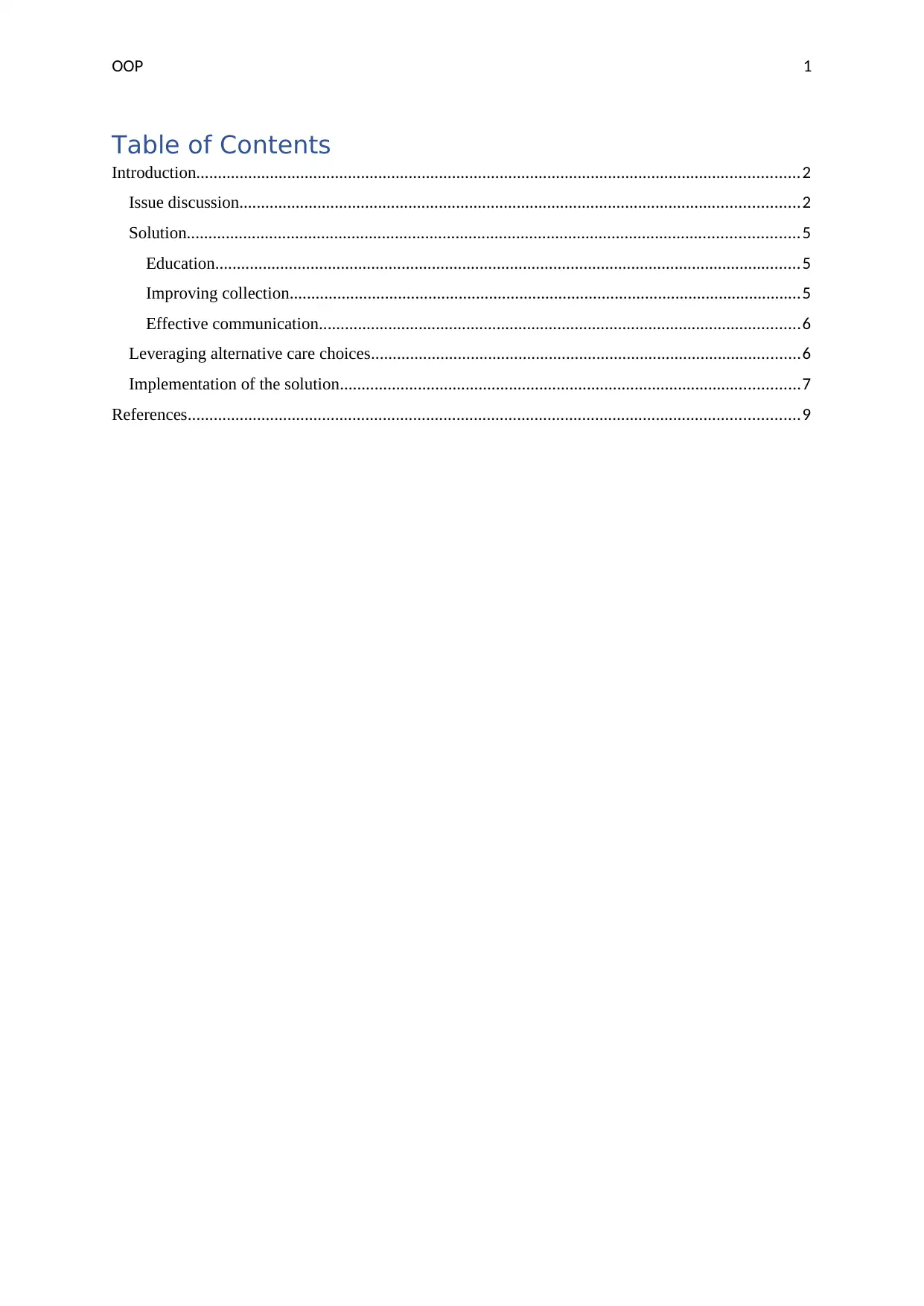
OOP 1
Table of Contents
Introduction...........................................................................................................................................2
Issue discussion.................................................................................................................................2
Solution.............................................................................................................................................5
Education.......................................................................................................................................5
Improving collection......................................................................................................................5
Effective communication...............................................................................................................6
Leveraging alternative care choices...................................................................................................6
Implementation of the solution..........................................................................................................7
References.............................................................................................................................................9
Table of Contents
Introduction...........................................................................................................................................2
Issue discussion.................................................................................................................................2
Solution.............................................................................................................................................5
Education.......................................................................................................................................5
Improving collection......................................................................................................................5
Effective communication...............................................................................................................6
Leveraging alternative care choices...................................................................................................6
Implementation of the solution..........................................................................................................7
References.............................................................................................................................................9
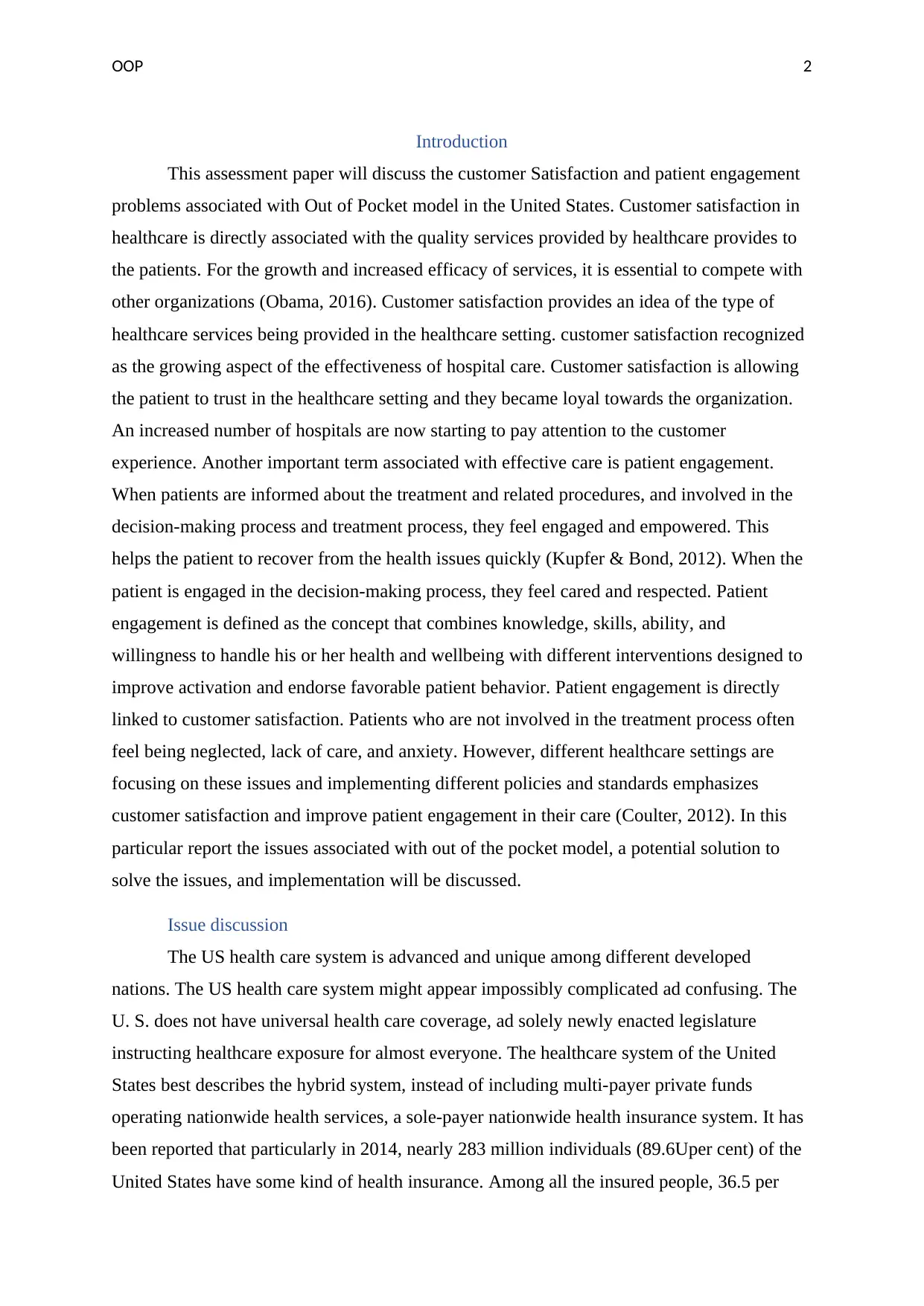
OOP 2
Introduction
This assessment paper will discuss the customer Satisfaction and patient engagement
problems associated with Out of Pocket model in the United States. Customer satisfaction in
healthcare is directly associated with the quality services provided by healthcare provides to
the patients. For the growth and increased efficacy of services, it is essential to compete with
other organizations (Obama, 2016). Customer satisfaction provides an idea of the type of
healthcare services being provided in the healthcare setting. customer satisfaction recognized
as the growing aspect of the effectiveness of hospital care. Customer satisfaction is allowing
the patient to trust in the healthcare setting and they became loyal towards the organization.
An increased number of hospitals are now starting to pay attention to the customer
experience. Another important term associated with effective care is patient engagement.
When patients are informed about the treatment and related procedures, and involved in the
decision-making process and treatment process, they feel engaged and empowered. This
helps the patient to recover from the health issues quickly (Kupfer & Bond, 2012). When the
patient is engaged in the decision-making process, they feel cared and respected. Patient
engagement is defined as the concept that combines knowledge, skills, ability, and
willingness to handle his or her health and wellbeing with different interventions designed to
improve activation and endorse favorable patient behavior. Patient engagement is directly
linked to customer satisfaction. Patients who are not involved in the treatment process often
feel being neglected, lack of care, and anxiety. However, different healthcare settings are
focusing on these issues and implementing different policies and standards emphasizes
customer satisfaction and improve patient engagement in their care (Coulter, 2012). In this
particular report the issues associated with out of the pocket model, a potential solution to
solve the issues, and implementation will be discussed.
Issue discussion
The US health care system is advanced and unique among different developed
nations. The US health care system might appear impossibly complicated ad confusing. The
U. S. does not have universal health care coverage, ad solely newly enacted legislature
instructing healthcare exposure for almost everyone. The healthcare system of the United
States best describes the hybrid system, instead of including multi-payer private funds
operating nationwide health services, a sole-payer nationwide health insurance system. It has
been reported that particularly in 2014, nearly 283 million individuals (89.6Uper cent) of the
United States have some kind of health insurance. Among all the insured people, 36.5 per
Introduction
This assessment paper will discuss the customer Satisfaction and patient engagement
problems associated with Out of Pocket model in the United States. Customer satisfaction in
healthcare is directly associated with the quality services provided by healthcare provides to
the patients. For the growth and increased efficacy of services, it is essential to compete with
other organizations (Obama, 2016). Customer satisfaction provides an idea of the type of
healthcare services being provided in the healthcare setting. customer satisfaction recognized
as the growing aspect of the effectiveness of hospital care. Customer satisfaction is allowing
the patient to trust in the healthcare setting and they became loyal towards the organization.
An increased number of hospitals are now starting to pay attention to the customer
experience. Another important term associated with effective care is patient engagement.
When patients are informed about the treatment and related procedures, and involved in the
decision-making process and treatment process, they feel engaged and empowered. This
helps the patient to recover from the health issues quickly (Kupfer & Bond, 2012). When the
patient is engaged in the decision-making process, they feel cared and respected. Patient
engagement is defined as the concept that combines knowledge, skills, ability, and
willingness to handle his or her health and wellbeing with different interventions designed to
improve activation and endorse favorable patient behavior. Patient engagement is directly
linked to customer satisfaction. Patients who are not involved in the treatment process often
feel being neglected, lack of care, and anxiety. However, different healthcare settings are
focusing on these issues and implementing different policies and standards emphasizes
customer satisfaction and improve patient engagement in their care (Coulter, 2012). In this
particular report the issues associated with out of the pocket model, a potential solution to
solve the issues, and implementation will be discussed.
Issue discussion
The US health care system is advanced and unique among different developed
nations. The US health care system might appear impossibly complicated ad confusing. The
U. S. does not have universal health care coverage, ad solely newly enacted legislature
instructing healthcare exposure for almost everyone. The healthcare system of the United
States best describes the hybrid system, instead of including multi-payer private funds
operating nationwide health services, a sole-payer nationwide health insurance system. It has
been reported that particularly in 2014, nearly 283 million individuals (89.6Uper cent) of the
United States have some kind of health insurance. Among all the insured people, 36.5 per
⊘ This is a preview!⊘
Do you want full access?
Subscribe today to unlock all pages.

Trusted by 1+ million students worldwide
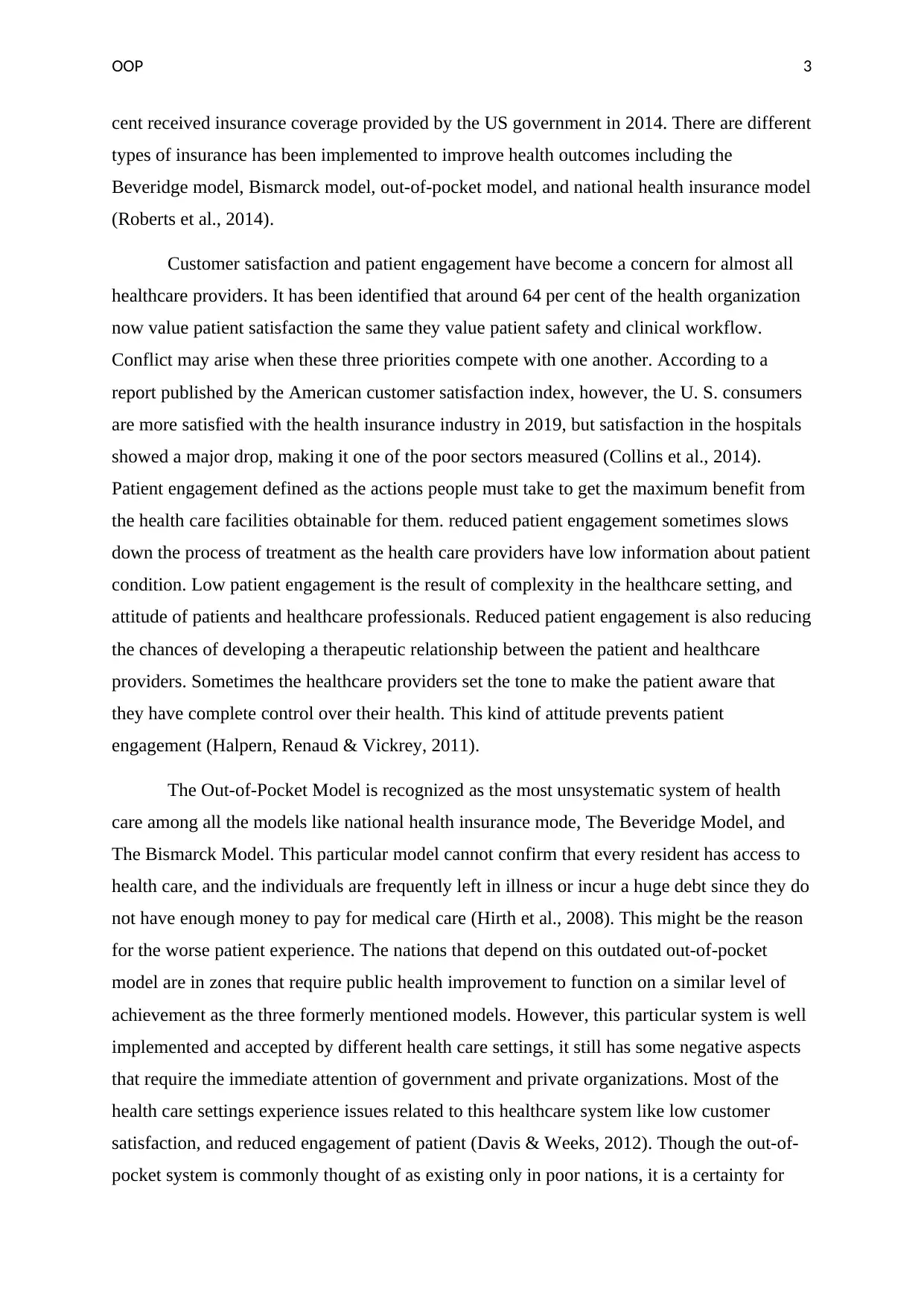
OOP 3
cent received insurance coverage provided by the US government in 2014. There are different
types of insurance has been implemented to improve health outcomes including the
Beveridge model, Bismarck model, out-of-pocket model, and national health insurance model
(Roberts et al., 2014).
Customer satisfaction and patient engagement have become a concern for almost all
healthcare providers. It has been identified that around 64 per cent of the health organization
now value patient satisfaction the same they value patient safety and clinical workflow.
Conflict may arise when these three priorities compete with one another. According to a
report published by the American customer satisfaction index, however, the U. S. consumers
are more satisfied with the health insurance industry in 2019, but satisfaction in the hospitals
showed a major drop, making it one of the poor sectors measured (Collins et al., 2014).
Patient engagement defined as the actions people must take to get the maximum benefit from
the health care facilities obtainable for them. reduced patient engagement sometimes slows
down the process of treatment as the health care providers have low information about patient
condition. Low patient engagement is the result of complexity in the healthcare setting, and
attitude of patients and healthcare professionals. Reduced patient engagement is also reducing
the chances of developing a therapeutic relationship between the patient and healthcare
providers. Sometimes the healthcare providers set the tone to make the patient aware that
they have complete control over their health. This kind of attitude prevents patient
engagement (Halpern, Renaud & Vickrey, 2011).
The Out-of-Pocket Model is recognized as the most unsystematic system of health
care among all the models like national health insurance mode, The Beveridge Model, and
The Bismarck Model. This particular model cannot confirm that every resident has access to
health care, and the individuals are frequently left in illness or incur a huge debt since they do
not have enough money to pay for medical care (Hirth et al., 2008). This might be the reason
for the worse patient experience. The nations that depend on this outdated out-of-pocket
model are in zones that require public health improvement to function on a similar level of
achievement as the three formerly mentioned models. However, this particular system is well
implemented and accepted by different health care settings, it still has some negative aspects
that require the immediate attention of government and private organizations. Most of the
health care settings experience issues related to this healthcare system like low customer
satisfaction, and reduced engagement of patient (Davis & Weeks, 2012). Though the out-of-
pocket system is commonly thought of as existing only in poor nations, it is a certainty for
cent received insurance coverage provided by the US government in 2014. There are different
types of insurance has been implemented to improve health outcomes including the
Beveridge model, Bismarck model, out-of-pocket model, and national health insurance model
(Roberts et al., 2014).
Customer satisfaction and patient engagement have become a concern for almost all
healthcare providers. It has been identified that around 64 per cent of the health organization
now value patient satisfaction the same they value patient safety and clinical workflow.
Conflict may arise when these three priorities compete with one another. According to a
report published by the American customer satisfaction index, however, the U. S. consumers
are more satisfied with the health insurance industry in 2019, but satisfaction in the hospitals
showed a major drop, making it one of the poor sectors measured (Collins et al., 2014).
Patient engagement defined as the actions people must take to get the maximum benefit from
the health care facilities obtainable for them. reduced patient engagement sometimes slows
down the process of treatment as the health care providers have low information about patient
condition. Low patient engagement is the result of complexity in the healthcare setting, and
attitude of patients and healthcare professionals. Reduced patient engagement is also reducing
the chances of developing a therapeutic relationship between the patient and healthcare
providers. Sometimes the healthcare providers set the tone to make the patient aware that
they have complete control over their health. This kind of attitude prevents patient
engagement (Halpern, Renaud & Vickrey, 2011).
The Out-of-Pocket Model is recognized as the most unsystematic system of health
care among all the models like national health insurance mode, The Beveridge Model, and
The Bismarck Model. This particular model cannot confirm that every resident has access to
health care, and the individuals are frequently left in illness or incur a huge debt since they do
not have enough money to pay for medical care (Hirth et al., 2008). This might be the reason
for the worse patient experience. The nations that depend on this outdated out-of-pocket
model are in zones that require public health improvement to function on a similar level of
achievement as the three formerly mentioned models. However, this particular system is well
implemented and accepted by different health care settings, it still has some negative aspects
that require the immediate attention of government and private organizations. Most of the
health care settings experience issues related to this healthcare system like low customer
satisfaction, and reduced engagement of patient (Davis & Weeks, 2012). Though the out-of-
pocket system is commonly thought of as existing only in poor nations, it is a certainty for
Paraphrase This Document
Need a fresh take? Get an instant paraphrase of this document with our AI Paraphraser
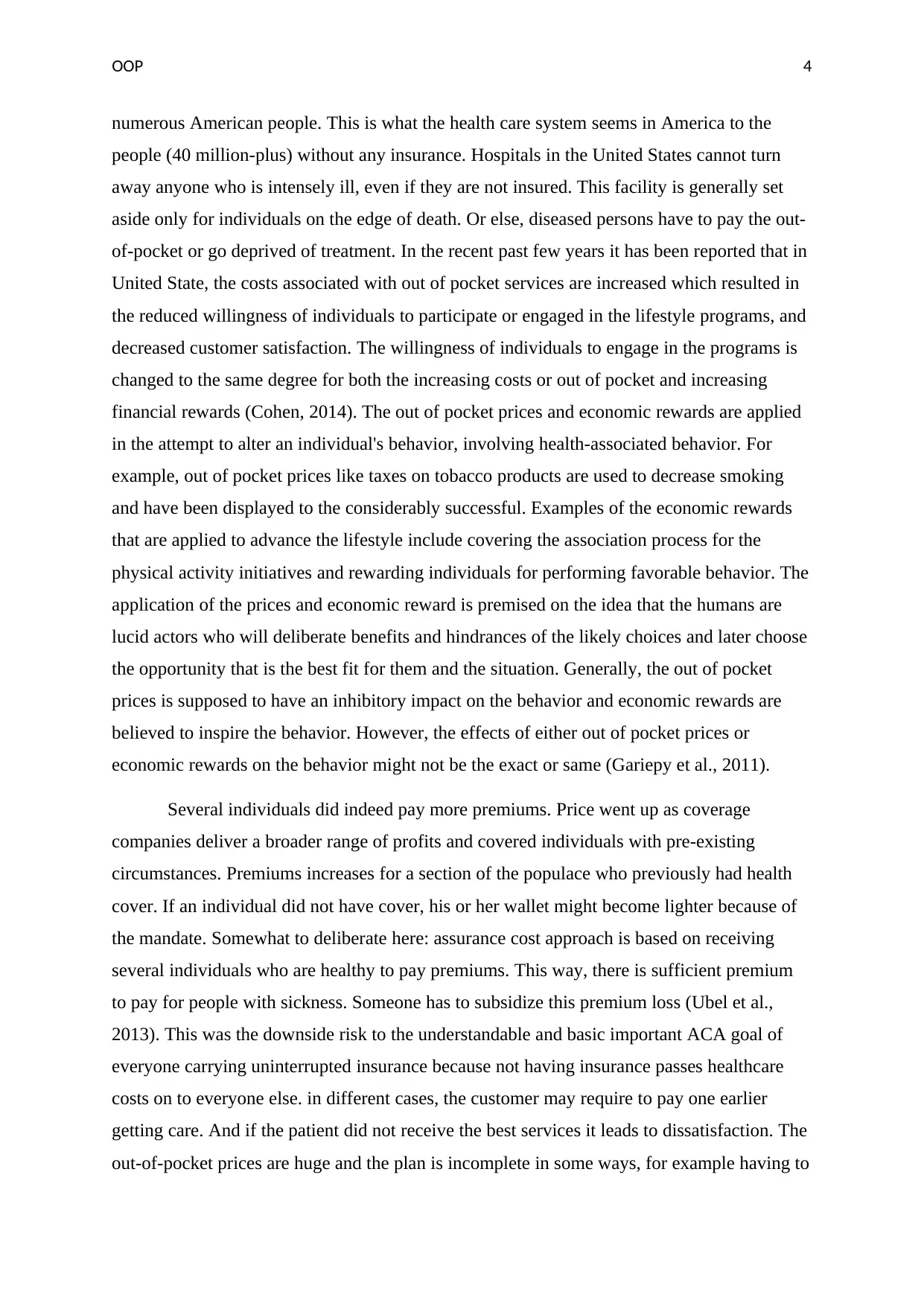
OOP 4
numerous American people. This is what the health care system seems in America to the
people (40 million-plus) without any insurance. Hospitals in the United States cannot turn
away anyone who is intensely ill, even if they are not insured. This facility is generally set
aside only for individuals on the edge of death. Or else, diseased persons have to pay the out-
of-pocket or go deprived of treatment. In the recent past few years it has been reported that in
United State, the costs associated with out of pocket services are increased which resulted in
the reduced willingness of individuals to participate or engaged in the lifestyle programs, and
decreased customer satisfaction. The willingness of individuals to engage in the programs is
changed to the same degree for both the increasing costs or out of pocket and increasing
financial rewards (Cohen, 2014). The out of pocket prices and economic rewards are applied
in the attempt to alter an individual's behavior, involving health-associated behavior. For
example, out of pocket prices like taxes on tobacco products are used to decrease smoking
and have been displayed to the considerably successful. Examples of the economic rewards
that are applied to advance the lifestyle include covering the association process for the
physical activity initiatives and rewarding individuals for performing favorable behavior. The
application of the prices and economic reward is premised on the idea that the humans are
lucid actors who will deliberate benefits and hindrances of the likely choices and later choose
the opportunity that is the best fit for them and the situation. Generally, the out of pocket
prices is supposed to have an inhibitory impact on the behavior and economic rewards are
believed to inspire the behavior. However, the effects of either out of pocket prices or
economic rewards on the behavior might not be the exact or same (Gariepy et al., 2011).
Several individuals did indeed pay more premiums. Price went up as coverage
companies deliver a broader range of profits and covered individuals with pre-existing
circumstances. Premiums increases for a section of the populace who previously had health
cover. If an individual did not have cover, his or her wallet might become lighter because of
the mandate. Somewhat to deliberate here: assurance cost approach is based on receiving
several individuals who are healthy to pay premiums. This way, there is sufficient premium
to pay for people with sickness. Someone has to subsidize this premium loss (Ubel et al.,
2013). This was the downside risk to the understandable and basic important ACA goal of
everyone carrying uninterrupted insurance because not having insurance passes healthcare
costs on to everyone else. in different cases, the customer may require to pay one earlier
getting care. And if the patient did not receive the best services it leads to dissatisfaction. The
out-of-pocket prices are huge and the plan is incomplete in some ways, for example having to
numerous American people. This is what the health care system seems in America to the
people (40 million-plus) without any insurance. Hospitals in the United States cannot turn
away anyone who is intensely ill, even if they are not insured. This facility is generally set
aside only for individuals on the edge of death. Or else, diseased persons have to pay the out-
of-pocket or go deprived of treatment. In the recent past few years it has been reported that in
United State, the costs associated with out of pocket services are increased which resulted in
the reduced willingness of individuals to participate or engaged in the lifestyle programs, and
decreased customer satisfaction. The willingness of individuals to engage in the programs is
changed to the same degree for both the increasing costs or out of pocket and increasing
financial rewards (Cohen, 2014). The out of pocket prices and economic rewards are applied
in the attempt to alter an individual's behavior, involving health-associated behavior. For
example, out of pocket prices like taxes on tobacco products are used to decrease smoking
and have been displayed to the considerably successful. Examples of the economic rewards
that are applied to advance the lifestyle include covering the association process for the
physical activity initiatives and rewarding individuals for performing favorable behavior. The
application of the prices and economic reward is premised on the idea that the humans are
lucid actors who will deliberate benefits and hindrances of the likely choices and later choose
the opportunity that is the best fit for them and the situation. Generally, the out of pocket
prices is supposed to have an inhibitory impact on the behavior and economic rewards are
believed to inspire the behavior. However, the effects of either out of pocket prices or
economic rewards on the behavior might not be the exact or same (Gariepy et al., 2011).
Several individuals did indeed pay more premiums. Price went up as coverage
companies deliver a broader range of profits and covered individuals with pre-existing
circumstances. Premiums increases for a section of the populace who previously had health
cover. If an individual did not have cover, his or her wallet might become lighter because of
the mandate. Somewhat to deliberate here: assurance cost approach is based on receiving
several individuals who are healthy to pay premiums. This way, there is sufficient premium
to pay for people with sickness. Someone has to subsidize this premium loss (Ubel et al.,
2013). This was the downside risk to the understandable and basic important ACA goal of
everyone carrying uninterrupted insurance because not having insurance passes healthcare
costs on to everyone else. in different cases, the customer may require to pay one earlier
getting care. And if the patient did not receive the best services it leads to dissatisfaction. The
out-of-pocket prices are huge and the plan is incomplete in some ways, for example having to
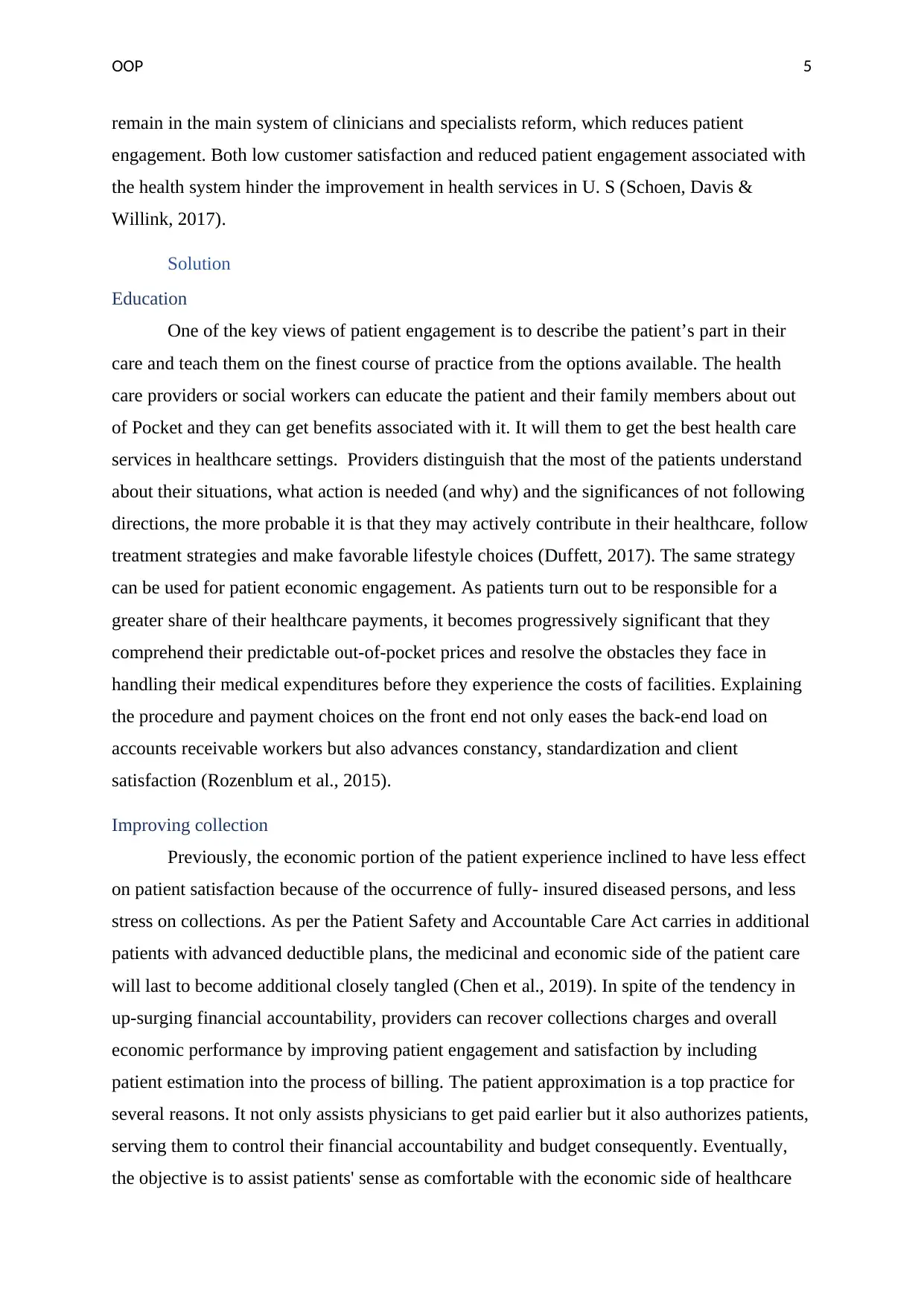
OOP 5
remain in the main system of clinicians and specialists reform, which reduces patient
engagement. Both low customer satisfaction and reduced patient engagement associated with
the health system hinder the improvement in health services in U. S (Schoen, Davis &
Willink, 2017).
Solution
Education
One of the key views of patient engagement is to describe the patient’s part in their
care and teach them on the finest course of practice from the options available. The health
care providers or social workers can educate the patient and their family members about out
of Pocket and they can get benefits associated with it. It will them to get the best health care
services in healthcare settings. Providers distinguish that the most of the patients understand
about their situations, what action is needed (and why) and the significances of not following
directions, the more probable it is that they may actively contribute in their healthcare, follow
treatment strategies and make favorable lifestyle choices (Duffett, 2017). The same strategy
can be used for patient economic engagement. As patients turn out to be responsible for a
greater share of their healthcare payments, it becomes progressively significant that they
comprehend their predictable out-of-pocket prices and resolve the obstacles they face in
handling their medical expenditures before they experience the costs of facilities. Explaining
the procedure and payment choices on the front end not only eases the back-end load on
accounts receivable workers but also advances constancy, standardization and client
satisfaction (Rozenblum et al., 2015).
Improving collection
Previously, the economic portion of the patient experience inclined to have less effect
on patient satisfaction because of the occurrence of fully- insured diseased persons, and less
stress on collections. As per the Patient Safety and Accountable Care Act carries in additional
patients with advanced deductible plans, the medicinal and economic side of the patient care
will last to become additional closely tangled (Chen et al., 2019). In spite of the tendency in
up-surging financial accountability, providers can recover collections charges and overall
economic performance by improving patient engagement and satisfaction by including
patient estimation into the process of billing. The patient approximation is a top practice for
several reasons. It not only assists physicians to get paid earlier but it also authorizes patients,
serving them to control their financial accountability and budget consequently. Eventually,
the objective is to assist patients' sense as comfortable with the economic side of healthcare
remain in the main system of clinicians and specialists reform, which reduces patient
engagement. Both low customer satisfaction and reduced patient engagement associated with
the health system hinder the improvement in health services in U. S (Schoen, Davis &
Willink, 2017).
Solution
Education
One of the key views of patient engagement is to describe the patient’s part in their
care and teach them on the finest course of practice from the options available. The health
care providers or social workers can educate the patient and their family members about out
of Pocket and they can get benefits associated with it. It will them to get the best health care
services in healthcare settings. Providers distinguish that the most of the patients understand
about their situations, what action is needed (and why) and the significances of not following
directions, the more probable it is that they may actively contribute in their healthcare, follow
treatment strategies and make favorable lifestyle choices (Duffett, 2017). The same strategy
can be used for patient economic engagement. As patients turn out to be responsible for a
greater share of their healthcare payments, it becomes progressively significant that they
comprehend their predictable out-of-pocket prices and resolve the obstacles they face in
handling their medical expenditures before they experience the costs of facilities. Explaining
the procedure and payment choices on the front end not only eases the back-end load on
accounts receivable workers but also advances constancy, standardization and client
satisfaction (Rozenblum et al., 2015).
Improving collection
Previously, the economic portion of the patient experience inclined to have less effect
on patient satisfaction because of the occurrence of fully- insured diseased persons, and less
stress on collections. As per the Patient Safety and Accountable Care Act carries in additional
patients with advanced deductible plans, the medicinal and economic side of the patient care
will last to become additional closely tangled (Chen et al., 2019). In spite of the tendency in
up-surging financial accountability, providers can recover collections charges and overall
economic performance by improving patient engagement and satisfaction by including
patient estimation into the process of billing. The patient approximation is a top practice for
several reasons. It not only assists physicians to get paid earlier but it also authorizes patients,
serving them to control their financial accountability and budget consequently. Eventually,
the objective is to assist patients' sense as comfortable with the economic side of healthcare
⊘ This is a preview!⊘
Do you want full access?
Subscribe today to unlock all pages.

Trusted by 1+ million students worldwide
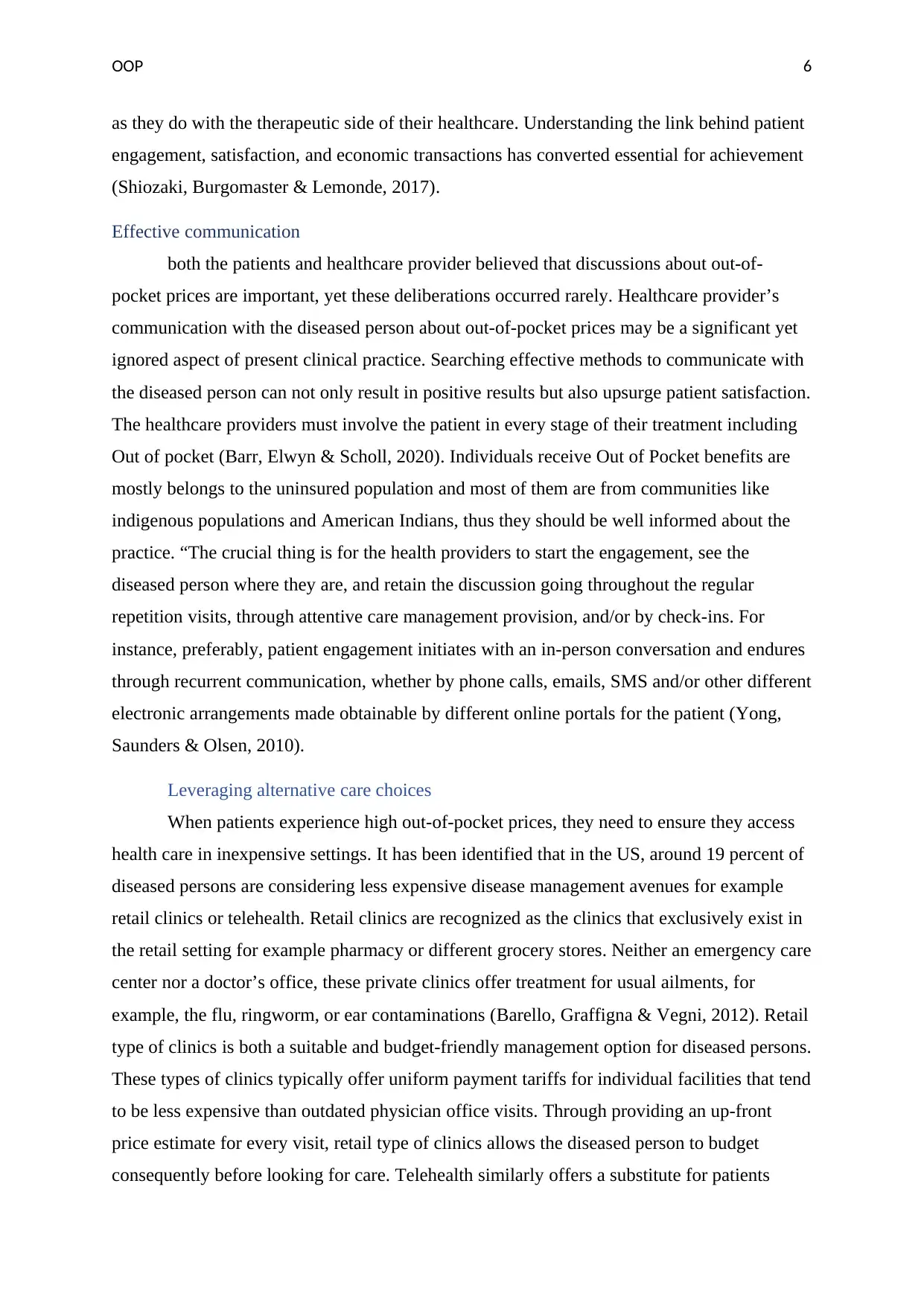
OOP 6
as they do with the therapeutic side of their healthcare. Understanding the link behind patient
engagement, satisfaction, and economic transactions has converted essential for achievement
(Shiozaki, Burgomaster & Lemonde, 2017).
Effective communication
both the patients and healthcare provider believed that discussions about out-of-
pocket prices are important, yet these deliberations occurred rarely. Healthcare provider’s
communication with the diseased person about out-of-pocket prices may be a significant yet
ignored aspect of present clinical practice. Searching effective methods to communicate with
the diseased person can not only result in positive results but also upsurge patient satisfaction.
The healthcare providers must involve the patient in every stage of their treatment including
Out of pocket (Barr, Elwyn & Scholl, 2020). Individuals receive Out of Pocket benefits are
mostly belongs to the uninsured population and most of them are from communities like
indigenous populations and American Indians, thus they should be well informed about the
practice. “The crucial thing is for the health providers to start the engagement, see the
diseased person where they are, and retain the discussion going throughout the regular
repetition visits, through attentive care management provision, and/or by check-ins. For
instance, preferably, patient engagement initiates with an in-person conversation and endures
through recurrent communication, whether by phone calls, emails, SMS and/or other different
electronic arrangements made obtainable by different online portals for the patient (Yong,
Saunders & Olsen, 2010).
Leveraging alternative care choices
When patients experience high out-of-pocket prices, they need to ensure they access
health care in inexpensive settings. It has been identified that in the US, around 19 percent of
diseased persons are considering less expensive disease management avenues for example
retail clinics or telehealth. Retail clinics are recognized as the clinics that exclusively exist in
the retail setting for example pharmacy or different grocery stores. Neither an emergency care
center nor a doctor’s office, these private clinics offer treatment for usual ailments, for
example, the flu, ringworm, or ear contaminations (Barello, Graffigna & Vegni, 2012). Retail
type of clinics is both a suitable and budget-friendly management option for diseased persons.
These types of clinics typically offer uniform payment tariffs for individual facilities that tend
to be less expensive than outdated physician office visits. Through providing an up-front
price estimate for every visit, retail type of clinics allows the diseased person to budget
consequently before looking for care. Telehealth similarly offers a substitute for patients
as they do with the therapeutic side of their healthcare. Understanding the link behind patient
engagement, satisfaction, and economic transactions has converted essential for achievement
(Shiozaki, Burgomaster & Lemonde, 2017).
Effective communication
both the patients and healthcare provider believed that discussions about out-of-
pocket prices are important, yet these deliberations occurred rarely. Healthcare provider’s
communication with the diseased person about out-of-pocket prices may be a significant yet
ignored aspect of present clinical practice. Searching effective methods to communicate with
the diseased person can not only result in positive results but also upsurge patient satisfaction.
The healthcare providers must involve the patient in every stage of their treatment including
Out of pocket (Barr, Elwyn & Scholl, 2020). Individuals receive Out of Pocket benefits are
mostly belongs to the uninsured population and most of them are from communities like
indigenous populations and American Indians, thus they should be well informed about the
practice. “The crucial thing is for the health providers to start the engagement, see the
diseased person where they are, and retain the discussion going throughout the regular
repetition visits, through attentive care management provision, and/or by check-ins. For
instance, preferably, patient engagement initiates with an in-person conversation and endures
through recurrent communication, whether by phone calls, emails, SMS and/or other different
electronic arrangements made obtainable by different online portals for the patient (Yong,
Saunders & Olsen, 2010).
Leveraging alternative care choices
When patients experience high out-of-pocket prices, they need to ensure they access
health care in inexpensive settings. It has been identified that in the US, around 19 percent of
diseased persons are considering less expensive disease management avenues for example
retail clinics or telehealth. Retail clinics are recognized as the clinics that exclusively exist in
the retail setting for example pharmacy or different grocery stores. Neither an emergency care
center nor a doctor’s office, these private clinics offer treatment for usual ailments, for
example, the flu, ringworm, or ear contaminations (Barello, Graffigna & Vegni, 2012). Retail
type of clinics is both a suitable and budget-friendly management option for diseased persons.
These types of clinics typically offer uniform payment tariffs for individual facilities that tend
to be less expensive than outdated physician office visits. Through providing an up-front
price estimate for every visit, retail type of clinics allows the diseased person to budget
consequently before looking for care. Telehealth similarly offers a substitute for patients
Paraphrase This Document
Need a fresh take? Get an instant paraphrase of this document with our AI Paraphraser
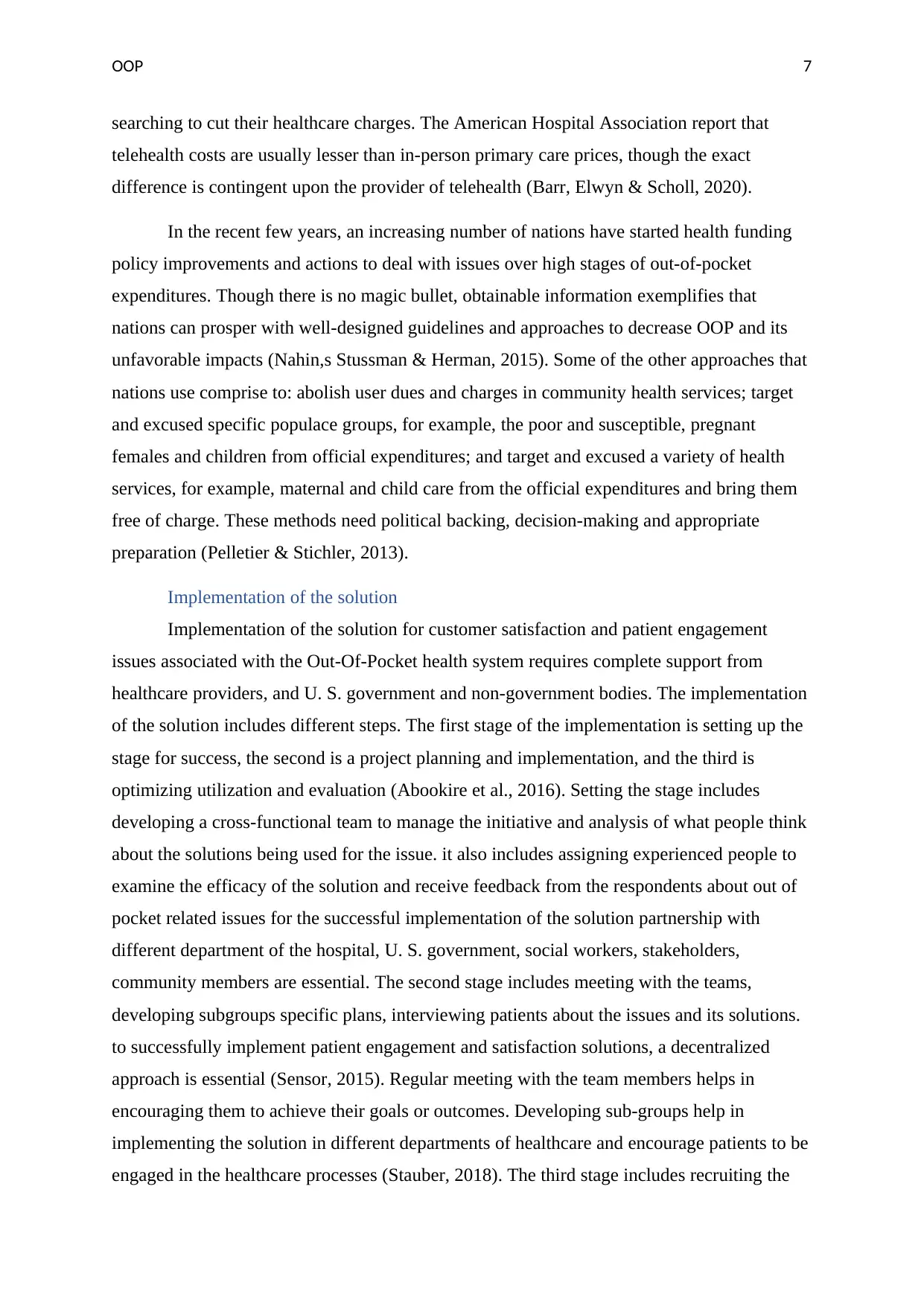
OOP 7
searching to cut their healthcare charges. The American Hospital Association report that
telehealth costs are usually lesser than in-person primary care prices, though the exact
difference is contingent upon the provider of telehealth (Barr, Elwyn & Scholl, 2020).
In the recent few years, an increasing number of nations have started health funding
policy improvements and actions to deal with issues over high stages of out-of-pocket
expenditures. Though there is no magic bullet, obtainable information exemplifies that
nations can prosper with well-designed guidelines and approaches to decrease OOP and its
unfavorable impacts (Nahin,s Stussman & Herman, 2015). Some of the other approaches that
nations use comprise to: abolish user dues and charges in community health services; target
and excused specific populace groups, for example, the poor and susceptible, pregnant
females and children from official expenditures; and target and excused a variety of health
services, for example, maternal and child care from the official expenditures and bring them
free of charge. These methods need political backing, decision-making and appropriate
preparation (Pelletier & Stichler, 2013).
Implementation of the solution
Implementation of the solution for customer satisfaction and patient engagement
issues associated with the Out-Of-Pocket health system requires complete support from
healthcare providers, and U. S. government and non-government bodies. The implementation
of the solution includes different steps. The first stage of the implementation is setting up the
stage for success, the second is a project planning and implementation, and the third is
optimizing utilization and evaluation (Abookire et al., 2016). Setting the stage includes
developing a cross-functional team to manage the initiative and analysis of what people think
about the solutions being used for the issue. it also includes assigning experienced people to
examine the efficacy of the solution and receive feedback from the respondents about out of
pocket related issues for the successful implementation of the solution partnership with
different department of the hospital, U. S. government, social workers, stakeholders,
community members are essential. The second stage includes meeting with the teams,
developing subgroups specific plans, interviewing patients about the issues and its solutions.
to successfully implement patient engagement and satisfaction solutions, a decentralized
approach is essential (Sensor, 2015). Regular meeting with the team members helps in
encouraging them to achieve their goals or outcomes. Developing sub-groups help in
implementing the solution in different departments of healthcare and encourage patients to be
engaged in the healthcare processes (Stauber, 2018). The third stage includes recruiting the
searching to cut their healthcare charges. The American Hospital Association report that
telehealth costs are usually lesser than in-person primary care prices, though the exact
difference is contingent upon the provider of telehealth (Barr, Elwyn & Scholl, 2020).
In the recent few years, an increasing number of nations have started health funding
policy improvements and actions to deal with issues over high stages of out-of-pocket
expenditures. Though there is no magic bullet, obtainable information exemplifies that
nations can prosper with well-designed guidelines and approaches to decrease OOP and its
unfavorable impacts (Nahin,s Stussman & Herman, 2015). Some of the other approaches that
nations use comprise to: abolish user dues and charges in community health services; target
and excused specific populace groups, for example, the poor and susceptible, pregnant
females and children from official expenditures; and target and excused a variety of health
services, for example, maternal and child care from the official expenditures and bring them
free of charge. These methods need political backing, decision-making and appropriate
preparation (Pelletier & Stichler, 2013).
Implementation of the solution
Implementation of the solution for customer satisfaction and patient engagement
issues associated with the Out-Of-Pocket health system requires complete support from
healthcare providers, and U. S. government and non-government bodies. The implementation
of the solution includes different steps. The first stage of the implementation is setting up the
stage for success, the second is a project planning and implementation, and the third is
optimizing utilization and evaluation (Abookire et al., 2016). Setting the stage includes
developing a cross-functional team to manage the initiative and analysis of what people think
about the solutions being used for the issue. it also includes assigning experienced people to
examine the efficacy of the solution and receive feedback from the respondents about out of
pocket related issues for the successful implementation of the solution partnership with
different department of the hospital, U. S. government, social workers, stakeholders,
community members are essential. The second stage includes meeting with the teams,
developing subgroups specific plans, interviewing patients about the issues and its solutions.
to successfully implement patient engagement and satisfaction solutions, a decentralized
approach is essential (Sensor, 2015). Regular meeting with the team members helps in
encouraging them to achieve their goals or outcomes. Developing sub-groups help in
implementing the solution in different departments of healthcare and encourage patients to be
engaged in the healthcare processes (Stauber, 2018). The third stage includes recruiting the
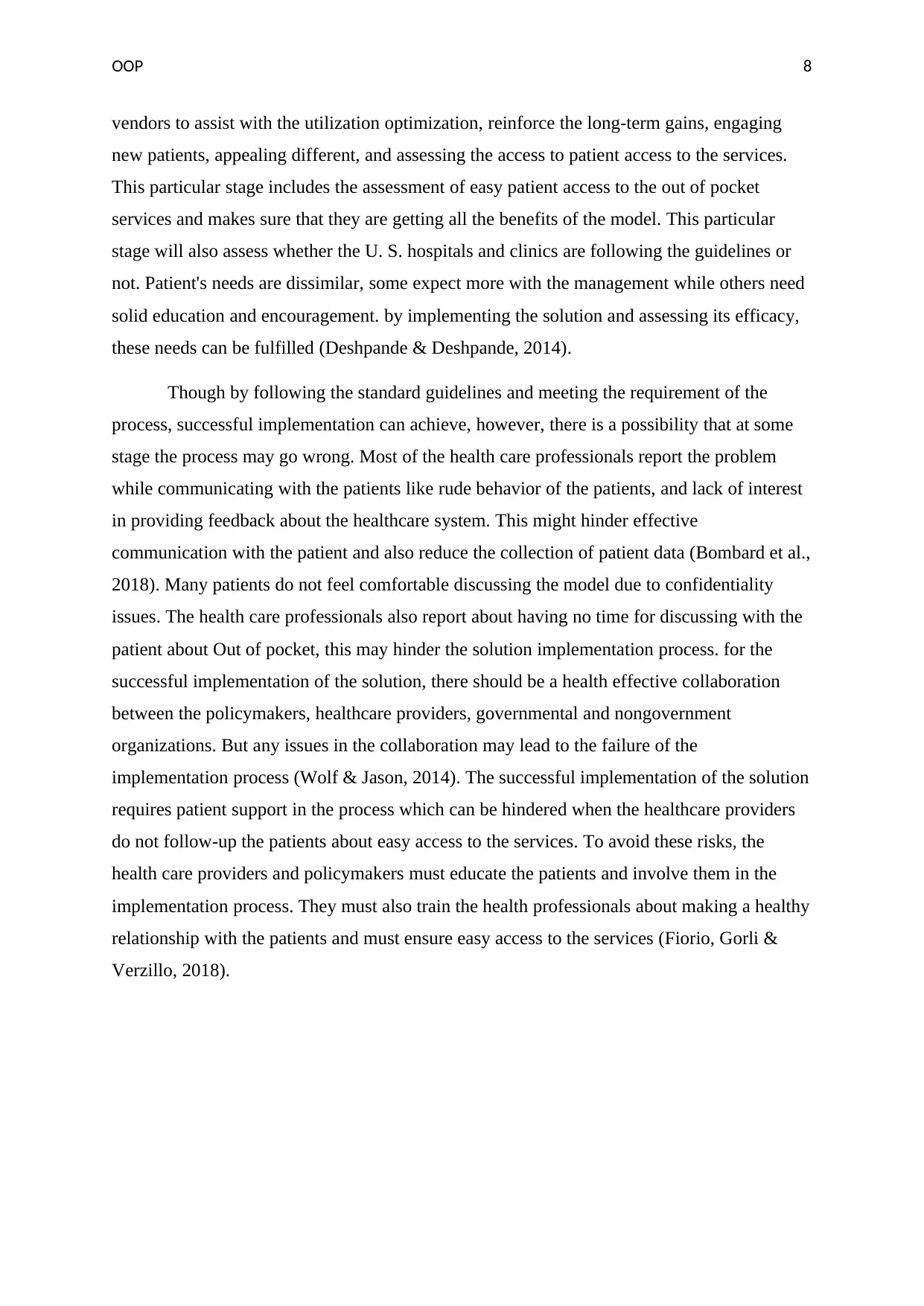
OOP 8
vendors to assist with the utilization optimization, reinforce the long-term gains, engaging
new patients, appealing different, and assessing the access to patient access to the services.
This particular stage includes the assessment of easy patient access to the out of pocket
services and makes sure that they are getting all the benefits of the model. This particular
stage will also assess whether the U. S. hospitals and clinics are following the guidelines or
not. Patient's needs are dissimilar, some expect more with the management while others need
solid education and encouragement. by implementing the solution and assessing its efficacy,
these needs can be fulfilled (Deshpande & Deshpande, 2014).
Though by following the standard guidelines and meeting the requirement of the
process, successful implementation can achieve, however, there is a possibility that at some
stage the process may go wrong. Most of the health care professionals report the problem
while communicating with the patients like rude behavior of the patients, and lack of interest
in providing feedback about the healthcare system. This might hinder effective
communication with the patient and also reduce the collection of patient data (Bombard et al.,
2018). Many patients do not feel comfortable discussing the model due to confidentiality
issues. The health care professionals also report about having no time for discussing with the
patient about Out of pocket, this may hinder the solution implementation process. for the
successful implementation of the solution, there should be a health effective collaboration
between the policymakers, healthcare providers, governmental and nongovernment
organizations. But any issues in the collaboration may lead to the failure of the
implementation process (Wolf & Jason, 2014). The successful implementation of the solution
requires patient support in the process which can be hindered when the healthcare providers
do not follow-up the patients about easy access to the services. To avoid these risks, the
health care providers and policymakers must educate the patients and involve them in the
implementation process. They must also train the health professionals about making a healthy
relationship with the patients and must ensure easy access to the services (Fiorio, Gorli &
Verzillo, 2018).
vendors to assist with the utilization optimization, reinforce the long-term gains, engaging
new patients, appealing different, and assessing the access to patient access to the services.
This particular stage includes the assessment of easy patient access to the out of pocket
services and makes sure that they are getting all the benefits of the model. This particular
stage will also assess whether the U. S. hospitals and clinics are following the guidelines or
not. Patient's needs are dissimilar, some expect more with the management while others need
solid education and encouragement. by implementing the solution and assessing its efficacy,
these needs can be fulfilled (Deshpande & Deshpande, 2014).
Though by following the standard guidelines and meeting the requirement of the
process, successful implementation can achieve, however, there is a possibility that at some
stage the process may go wrong. Most of the health care professionals report the problem
while communicating with the patients like rude behavior of the patients, and lack of interest
in providing feedback about the healthcare system. This might hinder effective
communication with the patient and also reduce the collection of patient data (Bombard et al.,
2018). Many patients do not feel comfortable discussing the model due to confidentiality
issues. The health care professionals also report about having no time for discussing with the
patient about Out of pocket, this may hinder the solution implementation process. for the
successful implementation of the solution, there should be a health effective collaboration
between the policymakers, healthcare providers, governmental and nongovernment
organizations. But any issues in the collaboration may lead to the failure of the
implementation process (Wolf & Jason, 2014). The successful implementation of the solution
requires patient support in the process which can be hindered when the healthcare providers
do not follow-up the patients about easy access to the services. To avoid these risks, the
health care providers and policymakers must educate the patients and involve them in the
implementation process. They must also train the health professionals about making a healthy
relationship with the patients and must ensure easy access to the services (Fiorio, Gorli &
Verzillo, 2018).
⊘ This is a preview!⊘
Do you want full access?
Subscribe today to unlock all pages.

Trusted by 1+ million students worldwide
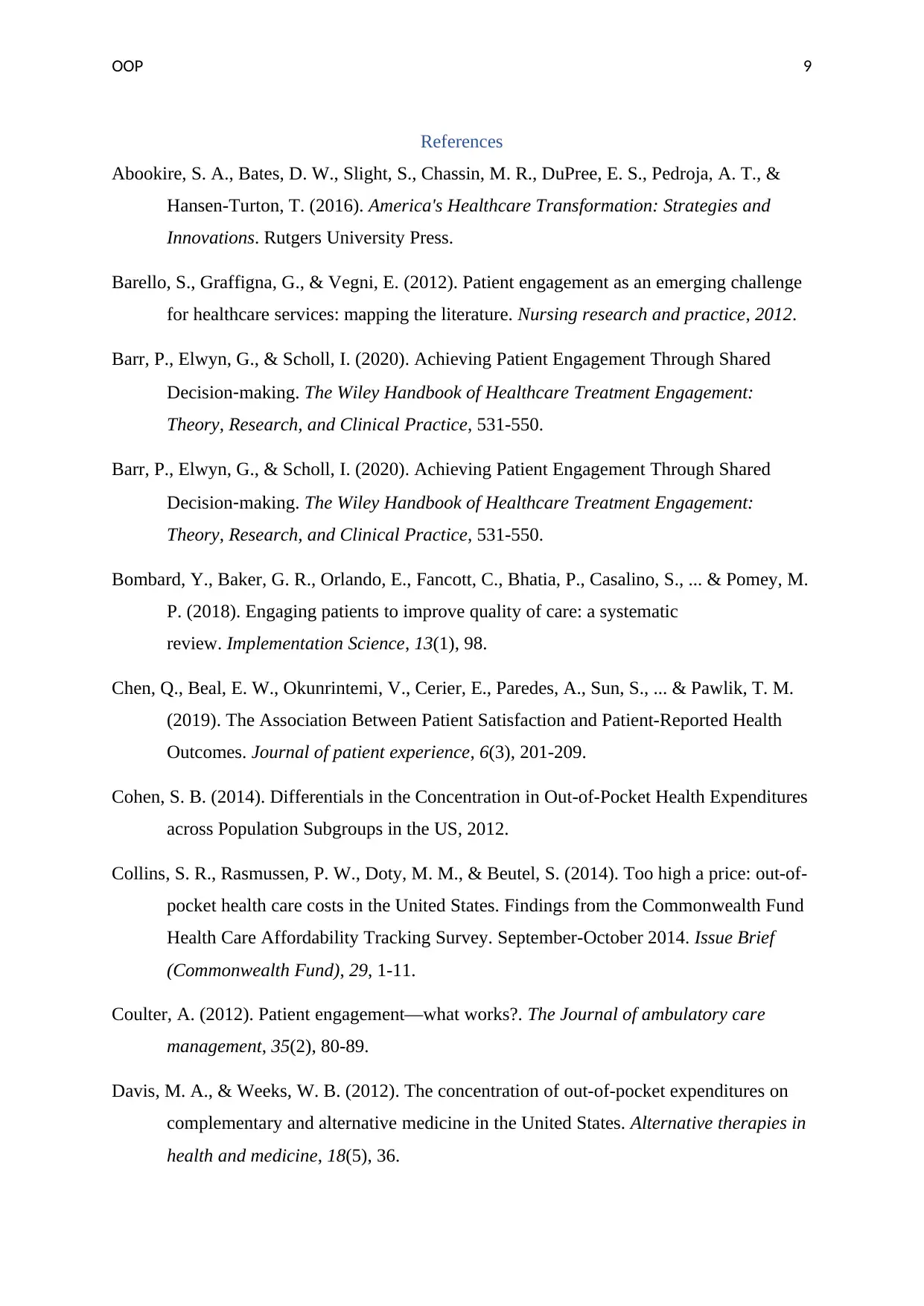
OOP 9
References
Abookire, S. A., Bates, D. W., Slight, S., Chassin, M. R., DuPree, E. S., Pedroja, A. T., &
Hansen-Turton, T. (2016). America's Healthcare Transformation: Strategies and
Innovations. Rutgers University Press.
Barello, S., Graffigna, G., & Vegni, E. (2012). Patient engagement as an emerging challenge
for healthcare services: mapping the literature. Nursing research and practice, 2012.
Barr, P., Elwyn, G., & Scholl, I. (2020). Achieving Patient Engagement Through Shared
Decision‐making. The Wiley Handbook of Healthcare Treatment Engagement:
Theory, Research, and Clinical Practice, 531-550.
Barr, P., Elwyn, G., & Scholl, I. (2020). Achieving Patient Engagement Through Shared
Decision‐making. The Wiley Handbook of Healthcare Treatment Engagement:
Theory, Research, and Clinical Practice, 531-550.
Bombard, Y., Baker, G. R., Orlando, E., Fancott, C., Bhatia, P., Casalino, S., ... & Pomey, M.
P. (2018). Engaging patients to improve quality of care: a systematic
review. Implementation Science, 13(1), 98.
Chen, Q., Beal, E. W., Okunrintemi, V., Cerier, E., Paredes, A., Sun, S., ... & Pawlik, T. M.
(2019). The Association Between Patient Satisfaction and Patient-Reported Health
Outcomes. Journal of patient experience, 6(3), 201-209.
Cohen, S. B. (2014). Differentials in the Concentration in Out-of-Pocket Health Expenditures
across Population Subgroups in the US, 2012.
Collins, S. R., Rasmussen, P. W., Doty, M. M., & Beutel, S. (2014). Too high a price: out-of-
pocket health care costs in the United States. Findings from the Commonwealth Fund
Health Care Affordability Tracking Survey. September-October 2014. Issue Brief
(Commonwealth Fund), 29, 1-11.
Coulter, A. (2012). Patient engagement—what works?. The Journal of ambulatory care
management, 35(2), 80-89.
Davis, M. A., & Weeks, W. B. (2012). The concentration of out-of-pocket expenditures on
complementary and alternative medicine in the United States. Alternative therapies in
health and medicine, 18(5), 36.
References
Abookire, S. A., Bates, D. W., Slight, S., Chassin, M. R., DuPree, E. S., Pedroja, A. T., &
Hansen-Turton, T. (2016). America's Healthcare Transformation: Strategies and
Innovations. Rutgers University Press.
Barello, S., Graffigna, G., & Vegni, E. (2012). Patient engagement as an emerging challenge
for healthcare services: mapping the literature. Nursing research and practice, 2012.
Barr, P., Elwyn, G., & Scholl, I. (2020). Achieving Patient Engagement Through Shared
Decision‐making. The Wiley Handbook of Healthcare Treatment Engagement:
Theory, Research, and Clinical Practice, 531-550.
Barr, P., Elwyn, G., & Scholl, I. (2020). Achieving Patient Engagement Through Shared
Decision‐making. The Wiley Handbook of Healthcare Treatment Engagement:
Theory, Research, and Clinical Practice, 531-550.
Bombard, Y., Baker, G. R., Orlando, E., Fancott, C., Bhatia, P., Casalino, S., ... & Pomey, M.
P. (2018). Engaging patients to improve quality of care: a systematic
review. Implementation Science, 13(1), 98.
Chen, Q., Beal, E. W., Okunrintemi, V., Cerier, E., Paredes, A., Sun, S., ... & Pawlik, T. M.
(2019). The Association Between Patient Satisfaction and Patient-Reported Health
Outcomes. Journal of patient experience, 6(3), 201-209.
Cohen, S. B. (2014). Differentials in the Concentration in Out-of-Pocket Health Expenditures
across Population Subgroups in the US, 2012.
Collins, S. R., Rasmussen, P. W., Doty, M. M., & Beutel, S. (2014). Too high a price: out-of-
pocket health care costs in the United States. Findings from the Commonwealth Fund
Health Care Affordability Tracking Survey. September-October 2014. Issue Brief
(Commonwealth Fund), 29, 1-11.
Coulter, A. (2012). Patient engagement—what works?. The Journal of ambulatory care
management, 35(2), 80-89.
Davis, M. A., & Weeks, W. B. (2012). The concentration of out-of-pocket expenditures on
complementary and alternative medicine in the United States. Alternative therapies in
health and medicine, 18(5), 36.
Paraphrase This Document
Need a fresh take? Get an instant paraphrase of this document with our AI Paraphraser
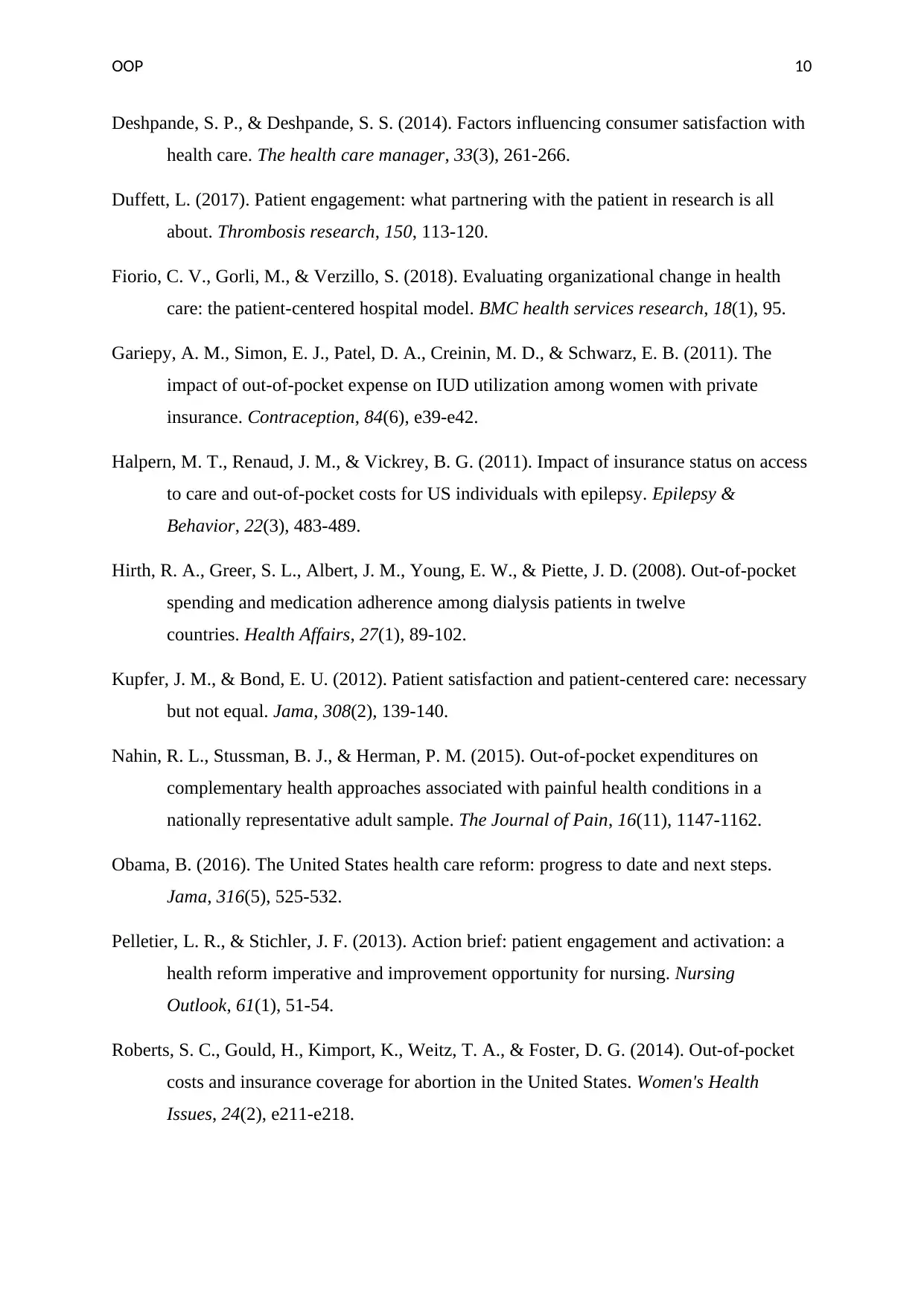
OOP 10
Deshpande, S. P., & Deshpande, S. S. (2014). Factors influencing consumer satisfaction with
health care. The health care manager, 33(3), 261-266.
Duffett, L. (2017). Patient engagement: what partnering with the patient in research is all
about. Thrombosis research, 150, 113-120.
Fiorio, C. V., Gorli, M., & Verzillo, S. (2018). Evaluating organizational change in health
care: the patient-centered hospital model. BMC health services research, 18(1), 95.
Gariepy, A. M., Simon, E. J., Patel, D. A., Creinin, M. D., & Schwarz, E. B. (2011). The
impact of out-of-pocket expense on IUD utilization among women with private
insurance. Contraception, 84(6), e39-e42.
Halpern, M. T., Renaud, J. M., & Vickrey, B. G. (2011). Impact of insurance status on access
to care and out-of-pocket costs for US individuals with epilepsy. Epilepsy &
Behavior, 22(3), 483-489.
Hirth, R. A., Greer, S. L., Albert, J. M., Young, E. W., & Piette, J. D. (2008). Out-of-pocket
spending and medication adherence among dialysis patients in twelve
countries. Health Affairs, 27(1), 89-102.
Kupfer, J. M., & Bond, E. U. (2012). Patient satisfaction and patient-centered care: necessary
but not equal. Jama, 308(2), 139-140.
Nahin, R. L., Stussman, B. J., & Herman, P. M. (2015). Out-of-pocket expenditures on
complementary health approaches associated with painful health conditions in a
nationally representative adult sample. The Journal of Pain, 16(11), 1147-1162.
Obama, B. (2016). The United States health care reform: progress to date and next steps.
Jama, 316(5), 525-532.
Pelletier, L. R., & Stichler, J. F. (2013). Action brief: patient engagement and activation: a
health reform imperative and improvement opportunity for nursing. Nursing
Outlook, 61(1), 51-54.
Roberts, S. C., Gould, H., Kimport, K., Weitz, T. A., & Foster, D. G. (2014). Out-of-pocket
costs and insurance coverage for abortion in the United States. Women's Health
Issues, 24(2), e211-e218.
Deshpande, S. P., & Deshpande, S. S. (2014). Factors influencing consumer satisfaction with
health care. The health care manager, 33(3), 261-266.
Duffett, L. (2017). Patient engagement: what partnering with the patient in research is all
about. Thrombosis research, 150, 113-120.
Fiorio, C. V., Gorli, M., & Verzillo, S. (2018). Evaluating organizational change in health
care: the patient-centered hospital model. BMC health services research, 18(1), 95.
Gariepy, A. M., Simon, E. J., Patel, D. A., Creinin, M. D., & Schwarz, E. B. (2011). The
impact of out-of-pocket expense on IUD utilization among women with private
insurance. Contraception, 84(6), e39-e42.
Halpern, M. T., Renaud, J. M., & Vickrey, B. G. (2011). Impact of insurance status on access
to care and out-of-pocket costs for US individuals with epilepsy. Epilepsy &
Behavior, 22(3), 483-489.
Hirth, R. A., Greer, S. L., Albert, J. M., Young, E. W., & Piette, J. D. (2008). Out-of-pocket
spending and medication adherence among dialysis patients in twelve
countries. Health Affairs, 27(1), 89-102.
Kupfer, J. M., & Bond, E. U. (2012). Patient satisfaction and patient-centered care: necessary
but not equal. Jama, 308(2), 139-140.
Nahin, R. L., Stussman, B. J., & Herman, P. M. (2015). Out-of-pocket expenditures on
complementary health approaches associated with painful health conditions in a
nationally representative adult sample. The Journal of Pain, 16(11), 1147-1162.
Obama, B. (2016). The United States health care reform: progress to date and next steps.
Jama, 316(5), 525-532.
Pelletier, L. R., & Stichler, J. F. (2013). Action brief: patient engagement and activation: a
health reform imperative and improvement opportunity for nursing. Nursing
Outlook, 61(1), 51-54.
Roberts, S. C., Gould, H., Kimport, K., Weitz, T. A., & Foster, D. G. (2014). Out-of-pocket
costs and insurance coverage for abortion in the United States. Women's Health
Issues, 24(2), e211-e218.
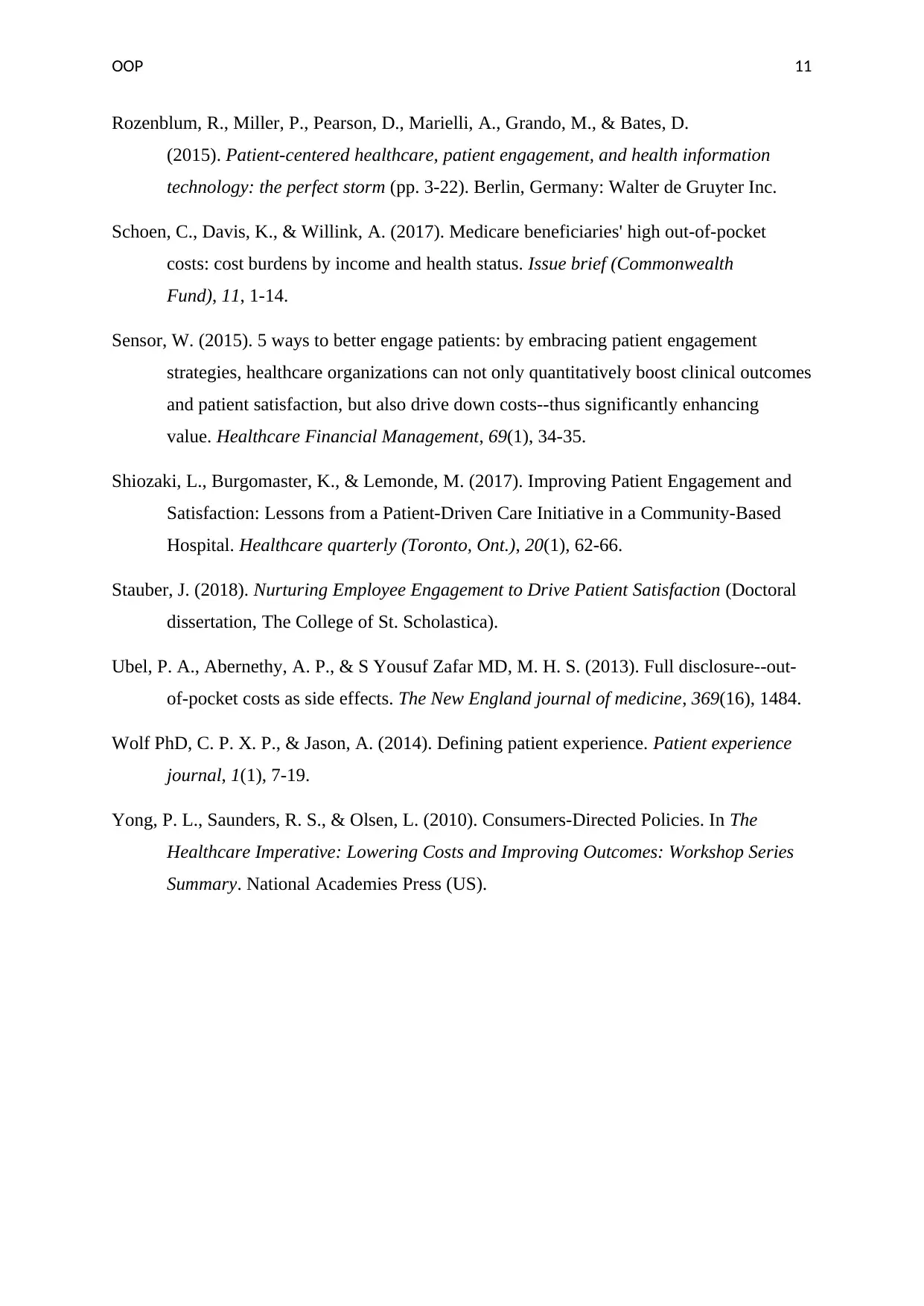
OOP 11
Rozenblum, R., Miller, P., Pearson, D., Marielli, A., Grando, M., & Bates, D.
(2015). Patient-centered healthcare, patient engagement, and health information
technology: the perfect storm (pp. 3-22). Berlin, Germany: Walter de Gruyter Inc.
Schoen, C., Davis, K., & Willink, A. (2017). Medicare beneficiaries' high out-of-pocket
costs: cost burdens by income and health status. Issue brief (Commonwealth
Fund), 11, 1-14.
Sensor, W. (2015). 5 ways to better engage patients: by embracing patient engagement
strategies, healthcare organizations can not only quantitatively boost clinical outcomes
and patient satisfaction, but also drive down costs--thus significantly enhancing
value. Healthcare Financial Management, 69(1), 34-35.
Shiozaki, L., Burgomaster, K., & Lemonde, M. (2017). Improving Patient Engagement and
Satisfaction: Lessons from a Patient-Driven Care Initiative in a Community-Based
Hospital. Healthcare quarterly (Toronto, Ont.), 20(1), 62-66.
Stauber, J. (2018). Nurturing Employee Engagement to Drive Patient Satisfaction (Doctoral
dissertation, The College of St. Scholastica).
Ubel, P. A., Abernethy, A. P., & S Yousuf Zafar MD, M. H. S. (2013). Full disclosure--out-
of-pocket costs as side effects. The New England journal of medicine, 369(16), 1484.
Wolf PhD, C. P. X. P., & Jason, A. (2014). Defining patient experience. Patient experience
journal, 1(1), 7-19.
Yong, P. L., Saunders, R. S., & Olsen, L. (2010). Consumers-Directed Policies. In The
Healthcare Imperative: Lowering Costs and Improving Outcomes: Workshop Series
Summary. National Academies Press (US).
Rozenblum, R., Miller, P., Pearson, D., Marielli, A., Grando, M., & Bates, D.
(2015). Patient-centered healthcare, patient engagement, and health information
technology: the perfect storm (pp. 3-22). Berlin, Germany: Walter de Gruyter Inc.
Schoen, C., Davis, K., & Willink, A. (2017). Medicare beneficiaries' high out-of-pocket
costs: cost burdens by income and health status. Issue brief (Commonwealth
Fund), 11, 1-14.
Sensor, W. (2015). 5 ways to better engage patients: by embracing patient engagement
strategies, healthcare organizations can not only quantitatively boost clinical outcomes
and patient satisfaction, but also drive down costs--thus significantly enhancing
value. Healthcare Financial Management, 69(1), 34-35.
Shiozaki, L., Burgomaster, K., & Lemonde, M. (2017). Improving Patient Engagement and
Satisfaction: Lessons from a Patient-Driven Care Initiative in a Community-Based
Hospital. Healthcare quarterly (Toronto, Ont.), 20(1), 62-66.
Stauber, J. (2018). Nurturing Employee Engagement to Drive Patient Satisfaction (Doctoral
dissertation, The College of St. Scholastica).
Ubel, P. A., Abernethy, A. P., & S Yousuf Zafar MD, M. H. S. (2013). Full disclosure--out-
of-pocket costs as side effects. The New England journal of medicine, 369(16), 1484.
Wolf PhD, C. P. X. P., & Jason, A. (2014). Defining patient experience. Patient experience
journal, 1(1), 7-19.
Yong, P. L., Saunders, R. S., & Olsen, L. (2010). Consumers-Directed Policies. In The
Healthcare Imperative: Lowering Costs and Improving Outcomes: Workshop Series
Summary. National Academies Press (US).
⊘ This is a preview!⊘
Do you want full access?
Subscribe today to unlock all pages.

Trusted by 1+ million students worldwide
1 out of 12
Related Documents
Your All-in-One AI-Powered Toolkit for Academic Success.
+13062052269
info@desklib.com
Available 24*7 on WhatsApp / Email
![[object Object]](/_next/static/media/star-bottom.7253800d.svg)
Unlock your academic potential
Copyright © 2020–2025 A2Z Services. All Rights Reserved. Developed and managed by ZUCOL.





